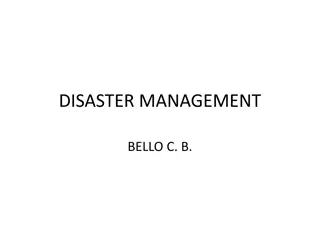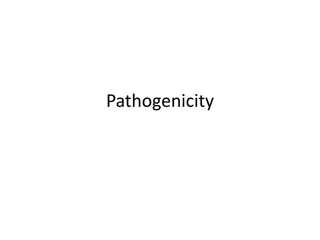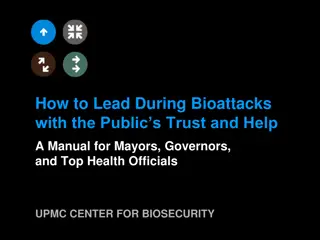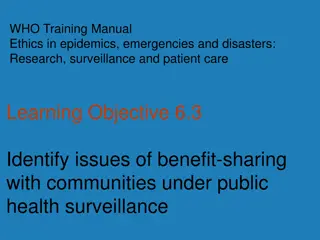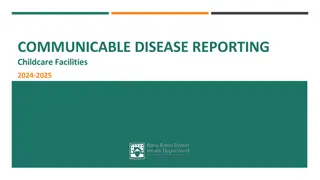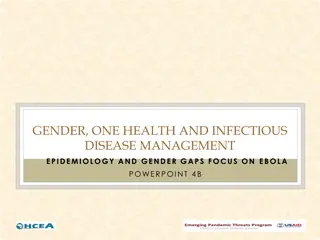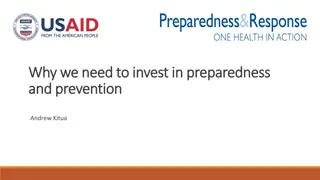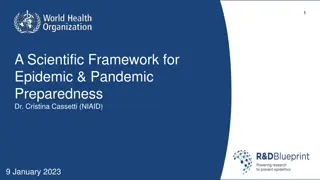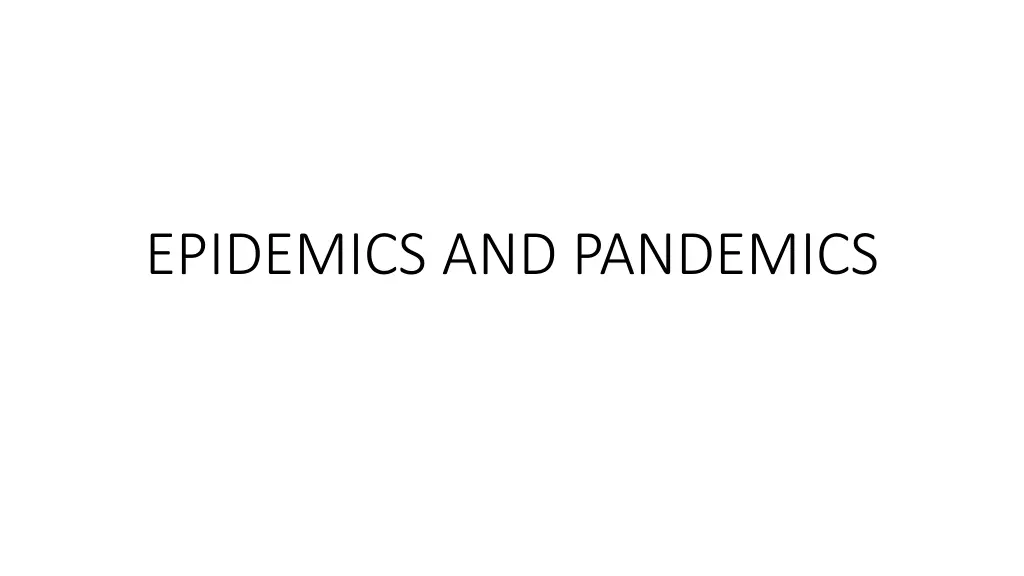
Historical Overview of Epidemics and Pandemics throughout the Ages
Explore a detailed historical account of devastating epidemics and pandemics, from the Plague of Athens to the Spanish Flu, highlighting significant events and their impact on populations. Learn about the Plague of Justinian, Black Death, Spanish Flu, Smallpox in the Americas, and the ongoing threat of Cholera pandemics. Delve into the origins, spread, and consequences of these significant health crises that have shaped human history.
Download Presentation

Please find below an Image/Link to download the presentation.
The content on the website is provided AS IS for your information and personal use only. It may not be sold, licensed, or shared on other websites without obtaining consent from the author. If you encounter any issues during the download, it is possible that the publisher has removed the file from their server.
You are allowed to download the files provided on this website for personal or commercial use, subject to the condition that they are used lawfully. All files are the property of their respective owners.
The content on the website is provided AS IS for your information and personal use only. It may not be sold, licensed, or shared on other websites without obtaining consent from the author.
E N D
Presentation Transcript
Plague of Athens (430 BC) Peloponnesian War between Athens and Sparta Plague lasted 3 years Killed ~25% of Athens population Including Pericles Likely Typhoid fever or a Hemorrhagic Fever like Ebola Caused a withdraw of the Spartans because they feared contact with the sick
Plague of Justinian (541-542 BC) Eastern Europe First major Bubonic Plague (Black Death) outbreak ~5000 people per day died in Constantanople (Istanbul) Lasted 2 years Killed tens of millions of people Played a key role in keeping the Byzantine Empire from expanding
Black Death (1347-1350) Arguably the worst pandemic in history Killed 1/3 of the population of Europe (75-200 million people) Caused by the Bubonic Plague Carried by fleas that lived on rats So many people died that the pandemic came to an end
Spanish Flu (1918-1920) H1N1 (swine flu) Spread worldwide because of the travel of soldiers during WWI Called the Spanish Flu because many thought Spain was hit hardest Other countries were under wartime censor and could not report things that were bad Spain was not at war, so they did not have this censor and reported the outbreak when others were not Infected over 500 million people Killed 3-5% of the world s population (50-100 million people) Estimated that of the US soldiers that died during WWI died of the flu Killed more people than the Bubonic Plague
Smallpox Americas (1633-1634) Brought to the New World by Europeans Killed 70-90% of the Native American population There have been multiple epidemics all over the globe of smallpox Smallpox has been eradicated due to world wide vaccination campaigns Smallpox caused many epidemics from (430 BC 1979 AD) Killed 5 monarchs
Cholera (1817 - present) 8 pandemics ~2-6 people died each day in the USA from 1832-1866 Because it spreads through infected water, it easily spreads through a community quickly. Kills over 100,000 people each year
Typhus (430 BC Present) Generally occurs after wars and natural disasters Can be carried by lice, and also transmitted through fecal matter Outbreaks in the US after the Civil War, World War I Major outbreaks in concentration camps during World War II Vaccines have greatly reduced this disease
Ebola (2014 - 2016) Began in Western Africa in 2014 Killed 5 times more people than any previous Ebola outbreak Ebola deaths - Figures up to 13 January 2016 11,315 Deaths - probable, confirmed and suspected 4,809 Liberia 3,955 Sierra Leone 2,536 Guinea 8 Nigeria 6 Mali 1 United States Researchers from the New England Journal of Medicine traced the outbreak to a two-year-old toddler, who died in December 2013 in Meliandou, a small village in south-eastern Guinea. In March, hospital staff alerted Guinea's Ministry of Health and then medical charity Medecins Sans Frontieres (MSF). They reported a mysterious disease in the south-eastern regions of Gueckedou, Macenta, Nzerekore, and Kissidougou. It caused fever, diarrhoea and vomiting. It also had a high death rate. Of the first 86 cases, 59 people died. Later determined by WHO to be Ebola
Epidemic A disease affecting an unusually large number of people in a community at the same time
How are Epidemics Caused Infected food and water Infected local water supplies affects a large population quickly Increased virulence Disease mutates and becomes more virulent Introduction of new disease Population has no resistance built to new disease Lower resistance to disease Natural disasters, famine, etc. can weaken a population and lower their resistance to a disease Natural disasters and wars Infected water, bringing new diseases, lowering resistance World travel
Spread of Disease Insects Bubonic Plague, Malaria Airborne Transmission Spread from person to person by sneezes or coughs Influenza, Measles, Tuberculosis Foods and Water Cholera, Dysentery, Typhoid Fever
Ending Epidemics Fewer Hosts many die, others survive and become resistant Vaccines to make resistant Quarantine keep other potential hosts away Seasonal Some diseases spread more easily during certain seasons Fewer Carriers Diseases carried by other organisms (mosquitoes, etc) can be stopped by A) getting rid of the carriers B) inactivity of the carriers due to seasons (mosquitoes are not active when it is cold)
When an Epidemic Becomes Pandemic Pandemic - Epidemic has spread across a large region, typically across multiple continents or worldwide
WHO World Health Organization Present in over 150 nations Directs and coordinates international health within the United Nations system
Outbreak Investigations Develop questionnaires Conduct surveys Analyze data Trace contacts Identify causes of disease outbreaks and other health threats Recommend control measures Devise strategies to prevent future occurrences.
During public health emergencies Deploys scientific experts Coordinates delivery of supplies and equipment to the incident site Monitors response activities Provides resources to state and local public health departments
Six Stages of a Pandemic - WHO 1. Disease is found in animals but not in humans 2. Disease is found in humans 3. Small clusters of the disease found, but is not spreading rapidly 4. Disease is being passed from human-to-human and there are community outbreaks 5. Disease has spread to at least two countries A full fledged pandemic is imminent 6. Disease is now classified as a full-fledged pandemic
Current Outbreaks Cholera Yemen Measles Romania Belgium Italy Germany Indonesia Guinea Meningitis Liberia Yellow Fever Brazil MERS Arabian Peninsula Malaria South Africa Burundi Guinea Indonesia Dengue Fiji Avian (Bird) Flu H7N9 China Chikungurya Central America South America Mexico Fiji Caribbean
ZIKA American Samoa Cayman Islands Guatemala Paraguay Uganda Peru Angola Central African Republic Guinea-Bissau United States of America Anguilla Chile Easter Island Guyana United States Virgin Islands Philippines Antigua and Barbuda Colombia Haiti Puerto Rico Vanuatu Argentina Cook Islands Honduras Saint Barthelemy Venezuela Aruba Costa Rica Indonesia Saint Kitts Vietnam Bahamas C te d'Ivoire Jamaica Saint Lucia Bangladesh Cuba Lao People's Democratic Republic Saint Martin Barbados Cura ao Malaysia Saint Vincent and the Grenadines Belize Dominica Maldives Samoa Bolivia Dominican Republic Areas Marshall Islands Senegal Bonaire Ecuador Mexico Singapore Brazil El Salvador Micronesia Sint Maarten British Virgin Fiji Montserrat Solomon Islands Burkina Faso France Martinique Nicaragua Suriname Burundi France Guyane Nigeria Thailand Cambodia Gabon Palau Tonga Cameroon Grenada Panama Trinidad and Tobago Cape Verde Guadeloupe Papua New Guinea Turks and Caicos islands



